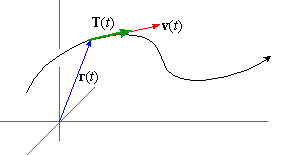Part 2: The Unit Tangent Vector
As we have seen already, vectors are often represented in a bold typeface. In addition, the magnitude of a vector is often denoted by the same letter, only in an
italic typeface. Thus, we often use r in
place of || r|| , and likewise, we often write
to denote the speed of an object. Given this new notation, we define the
unit tangent vector T( t) to be the unit
vector in the direction of v:

As a result, v = vT, which shows that velocity can be
written as the product of its speed and direction:
EXAMPLE 3 Find the unit tangent vector to r(t) =
á et, 2t, 2e-t
ñ .
Solution: To do so, we first compute the velocity:
|
v( t) = |
|
áet,2t,2e-t
ñ =
á et,2,-2e-t
ñ |
|
Then we find the magnitude of the velocity
Notice now that since ete-t = 1, the quantity under the square root
can be factored into a perfect square:
We then divide the velocity by the magnitude to obtain the unit tangent
vector:
|
T( t) = |
|
v = |
|

|
|
,
|
|
,
|
|

|
|
|
Check your Reading: How can T( t) change if its length is 1 for all t?



